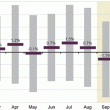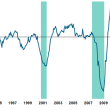In his inaugural blog post, Rick Rieder explores the fortunes of a sector he believes will help make or break the US economic recovery.
In the roughly 30 years that I’ve closely followed financial markets — the last few years in my role as Chief Investment Officer of Fundamental Fixed Income at BlackRock — one of the most important lessons I’ve learned is that markets generally can only concentrate on no more than a couple of things at a time. With that lesson in mind, I’d like to focus here on one of the vital things on the mind of the market now – one that also happens to be a pillar of growth that can help make or break the US economic recovery: housing.
First, a quick show of my hand: I think the US economy is in the process of emerging from significant structural headwinds, thanks to consumers and corporations strengthening their financial positions. And consumer finances should improve even more as housing recovers further – a virtuous cycle that matters a great deal for policy and investments.
Now the backstory that I believe gets us to that vision.
As you’ve no doubt heard ad nauseum from the financial media, the Federal Reserve’s QE, or “quantitative easing” – essentially, central bank purchasing of US Treasury and mortgage-backed debt through the expansion of its balance sheet — has strongly supported prices of financial assets over the past couple of years. Indeed, from the first quarter of 2008 to 2013, the vast majority of net worth gains (near 90%) stemmed from increasing financial asset prices, according to Royal Bank of Scotland research. Good news — provided you were fortunate enough to own stocks and other such assets.
But more recently QE has had a more democratized wealth impact as mortgage debt levels are falling and the value of residential homes is finally showing meaningful improvement, in part due to the Fed support. The upshot is that many middle-income households – not just those in the financial markets – are finally participating in these gains (see Figure 1).
Another encouraging sign is that home prices are historically affordable, despite the recent spike in mortgage rates. Further, consumer expectations and purchase survey data suggest that many potential buyers may move sooner rather than later. All good: More real estate transactions may feed through to further construction activity and increased growth.
Also, while the labor market recovery has been painfully slow and uneven; there are areas of improvement that may be positive for housing. For example, recent upward revisions in non-farm payroll numbers have meaningfully strengthened the average pace of jobs growth this year, despite a recent slowing in the metric. Moreover, outside the sectors I’ve deemed structurally impaired (construction, financial services and government), job gains have generally been on par with past cycles.
The point here is that housing is critical to broader economic recovery – in fact, the connection between houses and jobs alone is critical, as Figure 2 suggests.
Put it altogether, and you have to believe – I believe – that the Fed will do the right thing and keep interest rates “highly accommodative” for a considerable period of time, even as the central bank considers tapering its quantitative easing program. Such a monetary policy would help maintain affordable mortgage rates and could even counter the possible negative impact of other factors that could curtail loan growth, such as new and increased bank regulation.
So, while it may be easy to make a pessimistic medium-term case for the US economy in the wake of financial crisis and painful recession (alongside myriad risks still plaguing the globe), such a case doesn’t adequately account for several positives in our economic trajectory – housing being one of the key positives among them.
Now, some of you may be thinking: OK, but what about those financial assets he mentioned – where are those headed? In my next post I’ll talk about how economic growth and policy could affect asset class returns for the rest of the year. I look forward to continuing our conversation.















